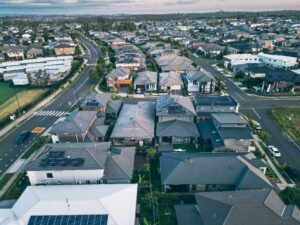Is a soft landing still likely in Australia in 2024?

Is Australia still set for a soft landing? For some months now, it was thought the answer was a firm yes. Some thought we were there already.
But this week, there is less uncertainty as to this question, specifically in light of US retail sales growth figures released earlier this week. The impact of the Stage 3 tax cuts will add a spanner in the works in Australia. Let’s take a look at the question as to whether or not a soft landing is the most likely outcome.
What is meant by the term soft landing?
The term “soft landing” refers to a scenario where an economy successfully slows down from rapid growth to a more sustainable growth rate without entering a recession. Generally the ‘growth’ is the economic growth rate (or GDP growth rate). But in the current economic cycle, this is alluding to the inflation rate.
Monetary and fiscal policies aim at controlling inflation but not to the extent that the economy will enter a recession. Inflation typically accelerates when an economy grows too quickly, leading to increased prices due to higher demand for goods and services. A soft landing aims to moderate this growth by implementing measures such as raising interest rates or reducing government spending to temper demand without stalling economic activity.
Central bankers hold the keys
Central banks, like the RBA, play a crucial role in achieving a soft landing. They use tools such as quantitative easing and interest rate adjustments to influence economic activity. Between May 2022 and November 2023, the RBA increased interest rates from 0.1% to 4.35%. By doing this, the RBA has make borrowing more expensive, which should theoretically reduce consumer spending and business investments. The challenge is to balance these rate hikes carefully to avoid tipping the economy into a recession.
There have been instances where economies have achieved a soft landing. For example, in the late 1990s, the U.S. Federal Reserve raised interest rates in several steps to cool the booming economy and high tech sector without causing a recession, leading to a period of sustained moderate growth – at least until 9/11 and the dot com bubble.
Is Australia still set for a soft landing?
In Australia, inflation was as high as 7% in the aftermath of the pandemic. Now it has cooled to just over 3%, nearly back to within the RBA’s target range, and the economy has not recorded a quarter of negative growth. So far so good. To answer the question: Australia appears to be set for a soft landing right now, although it is not set in stone.
With the bulk of mortgage holders in Australia now paying higher interest rates, you’d be forgiven for thinking a soft landing has been reached already. Not so fast though. It is no longer just about avoiding a recession as rates rise, but avoiding a further spike in economic activity as consumers adjust to the new norm and as rates begin falling.
Wait! There’s more!
Three other things need to be borne in mind. First, inflation is not quite back into the RBA’s target range. Second, although the Australian economy is growing, it is weak. The IMF forecasts just 1.4% growth in 2024 and the economy grew just 0.3% in the most recent quarter for which there are economic figures (the December 2023 quarter). Yes, you would take any positive figure compared to negative growth – something Japan and the UK had for two recent quarters, and fell into recession as a consequence. But this growth is down from 1.8% last year.
Third, there is the possibility that inflation could run hot again when the Stage 3 tax cuts come into effect from July, as well as when interest rates start declining. When this happens is anyone’s guess – perhaps not until next year, or late this year at the earliest.
What are the Best ASX Stocks to invest in right now?
Check our buy/sell tips

Blog Categories
Get Our Top 5 ASX Stocks for FY26
Recent Posts
Diversifying Portfolios with ASX Consumer Stocks: Opportunities and Risks
The ASX 200 has delivered significant volatility recently, and market participants observing the screens in 2025 understand the turbulence firsthand.…
Is Lendlease (ASX:LLC) out of the doldrums for good?
Lendlease (ASX:LLC) has for the past several years been the classic definition of a ‘value trap’. You think a good…
Here are the 2 most important stock market taxes that investors need to be aware on
As one of two certainties in life, investors need to be aware of stock market taxes. Investors may be liable…


